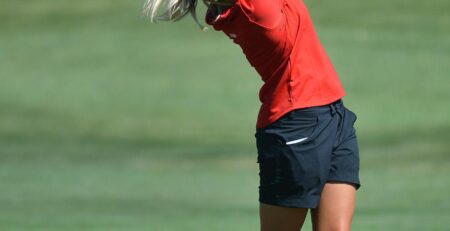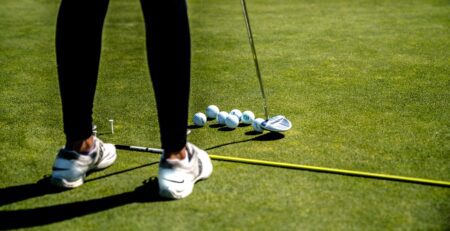Create The Science of the Golf Swing: Understanding the Mechanics and Physics
Golf is a sport that requires a combination of physical skill, mental focus, and technical precision. While many golfers focus primarily on their swing mechanics, understanding the science behind the golf swing can give players a deeper understanding of how to improve their performance on the course. The golf swing is a complex motion that involves a series of movements and interactions between the golfer’s body and the golf club. By understanding the mechanics and physics of the golf swing, golfers can make adjustments to their technique and equipment that can lead to more consistent and effective swings. In this article, we will explore the key scientific principles that underlie the golf swing and how golfers can use this knowledge to improve their game.
The Mechanics of the Golf Swing
The golf swing is a complex and intricate movement that involves the coordination of multiple body parts to generate clubhead speed and accuracy. The swing can be broken down into several phases, including the backswing, downswing, and follow-through. During the backswing, the golfer rotates their shoulders and hips while keeping their arms straight and the club on a plane. In the downswing, the golfer initiates the movement with their lower body and transfers weight from their back foot to their front foot, leading to the release of stored energy and the acceleration of the clubhead. The follow-through completes the swing and involves the extension of the arms and the rotation of the torso. The mechanics of the golf swing are influenced by several factors, including body type, flexibility, strength, and balance.

To achieve an efficient and effective swing, golfers must strive for proper form and technique. This includes maintaining a stable base and posture, keeping the club on a consistent plane, and achieving optimal clubhead speed and ball contact. Achieving proper swing mechanics also requires an understanding of the physics involved in the swing. The laws of motion, force, and momentum play a critical role in the swing, influencing factors such as clubhead speed, ball spin, and trajectory. By understanding the mechanics and physics of the golf swing, golfers can improve their technique and performance on the course.
The Physics of the Golf Swing
The golf swing is a complex movement that involves multiple forces and principles of physics. To understand the physics of the golf swing, it is essential to break down the various components of the swing. The swing can be divided into four main phases: the backswing, downswing, impact, and follow-through.
During the backswing, the golfer uses muscular force to rotate their torso and move the club into position. The downswing, on the other hand, relies more on the principles of kinetic energy and momentum. As the club moves down towards the ball, it gains speed and momentum, which is transferred to the ball upon impact.
The most critical phase of the swing in terms of physics is the moment of impact. At this point, the clubhead is moving at maximum velocity, and the ball is stationary. The goal is to transfer as much of the clubhead’s energy to the ball as possible. This is achieved through the principles of force and momentum, as well as the angle of the clubface at impact.
Finally, the follow-through involves releasing the energy generated during the swing and allowing the club to complete its natural motion. Understanding the physics behind each phase of the swing can help golfers make adjustments to their technique and maximise their performance on the course.
Common Swing Faults and Corrections
The golf swing is a complex motion that requires precision and coordination. Even the slightest deviation from proper technique can lead to errors in ball flight and accuracy. Common swing faults include:
- Swaying or sliding: This occurs when the body moves laterally during the backswing or downswing, leading to inconsistent contact and direction. Corrections include maintaining a stable lower body and focusing on rotation rather than lateral movement.
- Over-the-top: This fault occurs when the club moves outside the desired swing plane during the downswing, leading to a steep and slicing ball flight. Corrections include focusing on an inside-out swing path and maintaining proper wrist hinge.
- Casting: This fault occurs when the wrists release prematurely during the downswing, leading to a loss of power and accuracy. Corrections include maintaining wrist lag and proper sequencing of the swing.
- Chicken wing: This fault occurs when the lead elbow bends and points away from the body during impact, leading to a loss of power and control. Corrections include maintaining proper arm extension and following through with the swing.
By understanding the mechanics and physics of the golf swing and addressing common swing faults, golfers can improve their consistency and accuracy on the course.

Equipment and Technology in the Golf Swing
Equipment and technology have a significant impact on the golf swing. Golf clubs are designed to optimise swing mechanics and allow golfers to hit the ball longer and more accurately. The length, weight, and flex of the shaft, the shape of the clubhead, and the loft of the club all affect the way the club moves through the swing and the trajectory of the ball. Golfers can also use technology to improve their swing, such as launch monitors, which measure ball speed, spin rate, and launch angle, to fine-tune their swing mechanics. Additionally, video analysis software allows golfers to capture and review their swing, identifying areas for improvement. Another technological advancement in golf is the use of 3D motion analysis, which provides a comprehensive view of the golf swing, including body position and movement, club path, and ball flight. This technology allows coaches and golfers to analyse and make adjustments to the swing in a highly detailed and precise way. By understanding the role of equipment and technology in the golf swing, golfers can optimise their equipment choices and leverage technology to improve their mechanics and performance.
Conclusion
Golf is a complex sport that requires a combination of physical and mental skills to master. Understanding the science behind the golf swing can help golfers improve their game by making informed decisions about their swing mechanics, equipment, and training programs. By analysing the mechanics of the swing, golfers can identify areas for improvement and work on correcting common faults. Similarly, by understanding the physics behind the swing, golfers can optimise their swing speed and distance.











